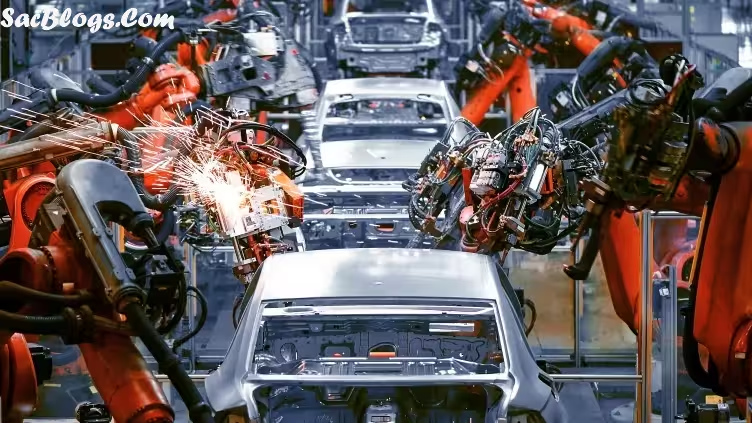Ai Automation in Pakistan ? In the bustling markets of Karachi and the manufacturing hubs of Faisalabad, a quiet revolution is underway. Artificial intelligence, robotics, and intelligent systems are progressively transforming how Pakistan works, produces, and competes. With a significant youth population and an economy balancing between agriculture and industry, Pakistan stands at a critical juncture where technological adoption could redefine its economic future. The pressing question for policymakers, business leaders, and workers alike is whether automation will prove to be a catalyst for economic growth or a disruptive force leading to widespread job displacement.
Table of Contents
The debate is complex and multifaceted. On one hand, ai automation promises enhanced productivity, global competitiveness, and the creation of new industries. On the other, it threatens to render certain job categories obsolete, potentially exacerbating unemployment and inequality. This article examines both dimensions of ai automation in Pakistan, analyzing sector-specific impacts, policy considerations, and pathways to ensure that the technological transition benefits the broader population. As Pakistan implements its National AI Policy 2025 and businesses increasingly adopt automated systems, understanding these dynamics becomes crucial for shaping an inclusive economic future .
The Current Landscape of Ai Automation in Pakistan
Pakistan’s automation journey is unfolding at varying paces across different sectors. The Pakistan Industrial Ai Automation Market is experiencing significant growth, driven by manufacturers’ need for operational efficiency, cost reduction, and improved productivity. Industries such as automotive, textiles, food and beverage, and pharmaceuticals are increasingly adopting robotics, control systems, and industrial software to streamline processes . This trend is further accelerated by government initiatives promoting Industry 4.0 principles and digital transformation, particularly under frameworks like the China-Pakistan Economic Corridor (CPEC) which encourages technological modernization .
Despite this momentum, adoption remains uneven. Large corporations and tech-focused enterprises are leading the way, while many small and medium-sized enterprises (SMEs)—the backbone of Pakistan’s economy—face significant barriers. These include high initial investment costs, limited awareness of ai automation technologies, and a shortage of skilled manpower to operate and maintain automated systems . Currently, approximately 15,000 professionals work in Pakistan’s AI sector, with projections suggesting this number could grow to 50,000 by 2029 as educational institutions expand their AI curricula and more universities offer specialized programs in emerging technologies .
| Sector | Level of Adoption | Primary Technologies | Key Drivers |
|---|---|---|---|
| Manufacturing | Moderate to High | Industrial Robots, SCADA, DCS | Cost reduction, quality control, global competitiveness |
| Agriculture | Low to Moderate | Drones, AI-powered irrigation, sensors | Water scarcity, yield improvement, climate challenges |
| Services (HR, Sales) | Moderate | AI chatbots, predictive analytics, ai automation tools | Efficiency, customer service improvement, personalization |
| Government | Emerging | Intelligent document processing, self-service kiosks | National AI Policy 2025, service efficiency, transparency |

Ai Automation as an Opportunity: The Upside of Technological Adoption
Job Creation in Emerging Fields
While ai automation may reduce certain manual roles, it simultaneously creates demand for new skill sets. The rising demand for AI specialists, data scientists, robotics engineers, and ai automation technicians represents a significant opportunity for Pakistan’s young, digitally-literate population. Currently, around 15,000 professionals work in AI-related fields, and this number is expected to grow substantially as companies continue their digital transformation journeys . Freelancing represents another promising avenue, with Pakistan already ranking among the world’s top countries for freelancing. AI skills are becoming increasingly valuable in the gig economy, allowing Pakistani professionals to offer services such as chatbot development, data analysis, and AI-based marketing ai automation to international clients .
Economic Growth and Global Competitiveness
Ai Automation technologies enhance productivity and operational efficiency, critical factors for Pakistani businesses competing in global markets. For instance, ai automation in the textile industry can increase efficiency and reduce production costs, making Pakistani exports more competitive against regional rivals like China and India . The World Bank notes that in developing economies similar to Pakistan, productivity gains from technology adoption often lead to increased scales of production that can offset labor-displacing effects . The Pakistan Institute of Development Economics (PIDE) estimates that ai automation could contribute an additional $3.5 billion to the national GDP by 2030 if implemented strategically .
Enhanced Productivity and Safety
In sectors like agriculture, which employs approximately 37.4% of Pakistan’s workforce, ai automation technologies such as AI-powered irrigation systems, drones for crop monitoring, and autonomous tractors are demonstrating tangible benefits. These innovations have been shown to boost crop yields by 20-30% while reducing pesticide usage by 15% and labor costs by up to 40% . In manufacturing, AI-powered visual inspection systems detect defects with greater accuracy than human inspectors, with one sports equipment manufacturer in Sialkot reporting a 45% reduction in quality-related returns after implementation . Beyond efficiency gains, ai automation can enhance workplace safety by handling hazardous tasks, particularly in manufacturing, construction, and mining operations.

Ai Automation as a Threat: Challenges and Displacement Risks
Job Displacement Across Sectors
The most immediate concern regarding ai automation is potential job displacement, particularly for roles involving routine, repetitive tasks. Research indicates that approximately 17% of jobs in Pakistan are at high risk of ai automation, with some studies suggesting that up to 1.2 million jobs could be displaced by 2030 . The manufacturing sector, which employs millions of workers, is particularly vulnerable, with estimates suggesting ai automation could decrease factory jobs by 25% to 40% over the next decade . This displacement risk extends beyond manufacturing to sectors like agriculture, where over 50% of rural workers rely on low-skilled farm labor that is increasingly being automated .
Widening Inequality and Social Implications
Ai Automation threatens to exacerbate existing socioeconomic inequalities in Pakistan. The benefits of ai automation tend to favor skilled workers who can work alongside new technologies, while less-skilled workers in routine and manual jobs face displacement risks. This disparity could deepen the divide between urban and rural areas, as tech hubs in cities like Karachi, Lahore, and Islamabad receive the bulk of investment while rural communities lag behind . Women, who constitute 70% of the rural agricultural workforce, are especially vulnerable to job displacement from ai automation, potentially reversing progress toward gender inclusion in the economy . As middle-income jobs diminish without adequate reskilling opportunities, income inequality could widen, creating social tensions and undermining the inclusive growth necessary for sustainable development.
Infrastructure and Implementation Challenges
Pakistan faces significant structural barriers to successfully integrating ai automation technologies. Only 22% of rural areas have reliable 4G internet access, creating a digital divide that hampers the adoption of digital tools essential for ai automation . The high initial investment required for ai automation technology presents a formidable barrier for many Pakistani businesses, particularly SMEs that form the backbone of the economy. Additionally, concerns about data security and privacy have gained prominence following incidents like NADRA’s warning about a 2.7 million-user data breach, highlighting the importance of robust cybersecurity measures alongside technological adoption .

Sector-Specific Impacts of Ai Automation
Manufacturing and Industrial Sector
Pakistan’s manufacturing sector faces significant transformation through ai automation. The textile industry, a cornerstone of the economy, is increasingly adopting AI-powered production lines and automated machinery to enhance productivity. One textile manufacturer in Faisalabad reported a 32% reduction in operational costs after implementing computer vision technology for quality control . While this increases efficiency, research suggests that ai automation could decrease factory jobs by 25-40% over the next decade, particularly affecting roles in assembly, packaging, and quality inspection . The adoption of industrial robots and control systems is also growing in automotive, food processing, and pharmaceutical industries, driven by the need to maintain global competitiveness .
Agriculture and Rural Economy
Approximately 62.7% of Pakistan’s population lives in rural areas where agriculture contributes 23% to GDP, making this sector crucial to the ai automation discussion . Ai Automation technologies such as drones, AI-driven irrigation systems, and automated harvesting equipment are gradually transforming farming practices. These innovations promise substantial benefits—precision agriculture technologies can increase yields by 20-30% while reducing resource inputs . However, the widespread adoption of such technologies threatens to displace a significant portion of agricultural laborers who lack alternative employment options. An OECD study warns that 45% of rural jobs in Pakistan are at high risk of ai automation, potentially leading to a 12% increase in rural unemployment by 2030 without targeted reskilling initiatives .
Services and Government Sectors
The services sector is experiencing perhaps the most rapid adoption of ai automation technologies. In human resources, approximately 75% of firms now use AI in recruitment, while 85% have implemented payroll ai automation . Generative AI could free 15-20% of HR professionals’ time from administrative tasks, allowing them to focus on strategic activities . Similarly, in sales, AI-powered tools are automating lead generation, customer service, and data analysis, potentially boosting productivity by approximately 20% . In government services, routine clerical roles in revenue collection, citizen services (like NADRA and passport offices), tax administration, and court clerking are increasingly automated through intelligent document processing and self-service kiosks . While this improves service efficiency, it necessitates significant workforce transition strategies.

Balancing the Scales: Policy Recommendations and Future Pathways
Education and Skills Development
Reforming Pakistan’s education and vocational training systems is fundamental to preparing the workforce for an automated future. This includes integrating digital literacy and STEM education at all levels, expanding technical training programs in AI, data analytics, and robotics, and developing partnerships between educational institutions and industries to ensure curriculum relevance. The National AI Policy 2025 represents a step in the right direction, with its emphasis on large-scale training and Centers of Excellence . Successful models like the DigiSkills Pakistan portal, which has trained millions through free online courses, should be expanded and enhanced with more advanced technical content . Continuing education and reskilling programs for current workers are equally important, particularly for mid-career professionals in high-risk occupations.
Strategic Policy Interventions
Effective policy frameworks are essential to maximize ai automation’s benefits while mitigating negative impacts. These should include tax incentives and financial support for SMEs adopting ai automation technologies, investment in digital infrastructure (particularly rural broadband expansion), and social safety nets for workers during transition periods. Policies should also promote research and development in ai automation technologies suited to Pakistan’s specific context, such as affordable agricultural ai automation solutions for smallholder farmers. Critically, Pakistan must avoid “excessive ai automation” driven by policy distortions that favor capital over labor, instead seeking a balanced approach that aligns with social optimality .
Fostering Inclusive Growth
Ensuring that ai automation benefits a broad segment of society requires deliberate inclusion strategies. These should address the digital gender divide through targeted programs encouraging women’s participation in technology fields, support for traditional industries transitioning to automated processes, and regional development initiatives to prevent geographic inequality. Special attention should be given to protecting vulnerable groups, including rural workers, women, and those in the informal economy who may be disproportionately affected by ai automation-related disruptions. Inclusive ai automation also means creating pathways for workers to participate in the digital economy through platforms, gig work, and entrepreneurial opportunities enabled by new technologies.

Conclusion: Navigating the Future of Work in Pakistan
Ai Automation presents Pakistan with both unprecedented opportunities and significant challenges. The technology offers a pathway to enhanced productivity, economic growth, and global competitiveness but also risks exacerbating unemployment, inequality, and social disruption if mismanaged. The question of whether ai automation represents an opportunity or threat for jobs in Pakistan cannot be answered with simple binary logic—the outcome will depend fundamentally on how the transition is managed through policy, education, and strategic planning.
The coming decade will be crucial for Pakistan to harness the benefits of ai automation while mitigating its risks. This will require collaborative efforts between government, private sector, educational institutions, and civil society to develop comprehensive strategies that prioritize workforce development, social protection, and inclusive growth. With proactive approach and strategic investment in its human capital, Pakistan can transform the ai automation challenge into an opportunity for sustainable development and improved living standards for all its citizens.
Read Also: Can AI Revolutionize Pakistan’s Productivity Challenges? Opportunities and Realities
Frequently Asked Questions (FAQs)
1. What percentage of jobs in Pakistan are at risk due to Ai Automation?
Research indicates that approximately 17% of jobs in Pakistan are at high risk of ai automation, with some studies suggesting that up to 1.2 million jobs could be displaced by 2030 if current trends continue without adequate intervention .
2. Which sectors in Pakistan are most vulnerable to job Ai Automation?
The most vulnerable sectors include manufacturing (particularly textiles and automobiles), agriculture, and routine service jobs in retail, data entry, and customer service. These sectors have a high proportion of routine, repetitive tasks that are technically easier to automate .
3. Can Ai Automation create new job opportunities in Pakistan?
Yes, ai automation is already creating new opportunities in fields such as AI development, data science, robotics engineering, cybersecurity, and automation maintenance. Pakistan’s growing freelance sector also offers opportunities for workers with AI-related skills to serve international clients .
4. How is the Pakistani government addressing the challenges of Ai Automation?
The government has introduced a National AI Policy 2025 that includes plans for large-scale training, Centers of Excellence, and public-sector pilots to modernize services. The policy also emphasizes reskilling programs and social safety nets for workers affected by automation .
5. What skills will be most valuable in an automated economy in Pakistan?
Technical skills in AI, data analytics, robotics, and digital literacy will be highly valuable, along with soft skills such as critical thinking, creativity, and emotional intelligence that are difficult to automate. Hybrid skills combining technical knowledge with industry-specific expertise will be particularly valuable .
6. How is Ai Automation affecting rural employment in Pakistan?
Automation in agriculture threatens to displace many low-skilled farm workers, with estimates suggesting 45% of rural jobs are at high risk. However, it also creates new opportunities in areas like drone operation, AI system maintenance, and precision agriculture technology support .
7. What can current workers do to prepare for increased Ai Automation?
Workers should focus on continuous learning and skills development, particularly in areas that complement rather than compete with automation. Taking advantage of reskilling programs, developing digital literacy, and cultivating uniquely human skills like problem-solving and adaptability can help workers remain relevant .
8. How are small and medium enterprises (SMEs) in Pakistan adopting Ai Automation?
SMEs face significant barriers to adoption including high costs and limited technical expertise, with only about 5% able to afford AI tools currently. However, cloud-based solutions and government-academia partnerships are making automation more accessible to smaller businesses .
9. Is artificial intelligence already being used in Pakistani businesses?
Yes, AI is being implemented across various sectors in Pakistan. Approximately 75% of firms use AI in recruitment processes, and major industries like banking, telecommunications, and manufacturing are increasingly adopting AI solutions for customer service, quality control, and operational efficiency .
10. What are the ethical considerations surrounding Ai Automation in Pakistan?
Key ethical considerations include data privacy concerns (highlighted by incidents like the NADRA data breach), algorithmic bias, transparency in automated decision-making, and ensuring that automation benefits are distributed fairly across society .







1 thought on “Ai Automation in Pakistan – Opportunity or Threat for Jobs in 2025?”